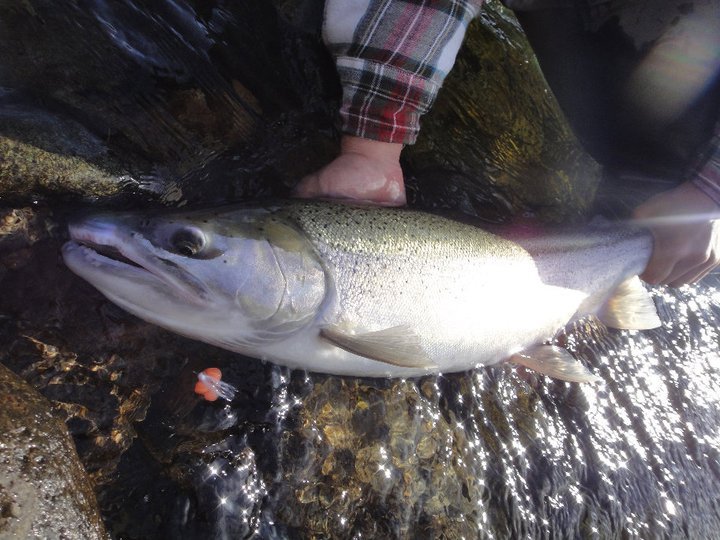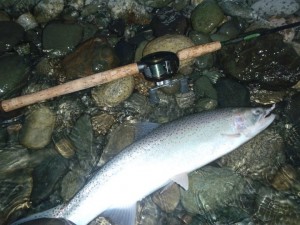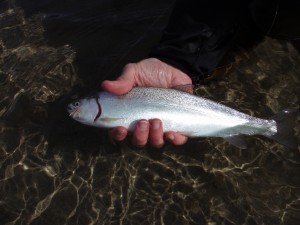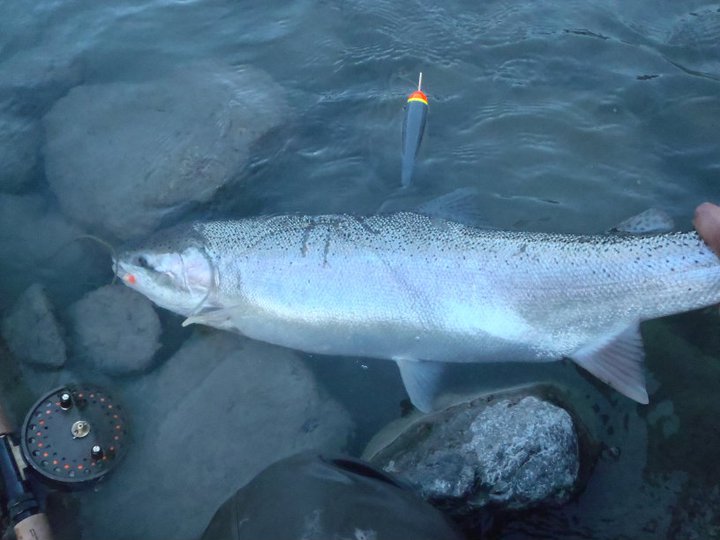Pacific Angler Outlook:
HAPPY NEW YEAR from the Pacific Angler Team – We had a busy 2012 and we are excited about 2013. Our New Years resolutions are numerous and lofty (Kamchatka 2014 anyone?) but one resolution is simple – We plan to keep our famous Friday fishing reports going strong with as much helpful info as we can!
It looks as though the New Year is going to bring the first solid rain in some time. When the weather is cold and dry for an extended period, fishing can be difficult and writing the report is hard but it looks like things are going to change! We might need to batten down the hatches and get ready for the first storm of the year. While you wait, start tying steelhead flies, oil your center pin and make sure your Islanders have fresh line on them as fishing is about to get good! Saturday, Sunday and Monday are scheduled for big rain with relatively warm temperatures. This means that all the rivers in the Lower Mainland should be amazing when things settle after the storm. Anytime we get a bump of rain it’s good for fishing but when a few factors combine it can make for something special. We have our fingers crossed that this weather event will be one of those “perfect storms” for fishing.
To make the perfect storm there are a few things to look for. First, a long period of low water leading up to the storm. This low water tends to keep fresh waves of fish from entering the river as they choose to stage in the ocean, Fraser, or Harrison, waiting for a good bump of water to bring them into the river they call home. Long periods of low water will also slow the volume of nutrients in the river. Eggs, bugs and other food items will stop flowing down stream and this affects the entire ecosystem, from the smallest stonefly, to the sculpin right up to the bull trout, cutthroat and ultimately the steelhead. Everything in the river is cold blooded and simply shuts down in an effort to conserve energy. This is bad news for fishing but the longer they stay hunkered down the more aggressive they will be when things change. The second the rivers bump up all the fish that have been staging come in and the ones that are already in the river move around and wake up. While the river is blown out they forget about all the gear that they have seen during the low and clear conditions so when the river comes back into shape, they are eager biters!
The second thing we hope for is timing. The ultimate is when we get a big rain event in conjunction with large tides and traditional migration timing. This can really make for some serious amounts of chrome steelhead entering the river. We are just coming off some huge tides from the full moon at the end of December and there is usually a good bump of winter steelhead in late Decmeber or early January, so we should see some of this effect. The rain will also get the fish that are already in the river moving around and get the nutrient levels up for the Dolly Varden, rainbows and cutthroat.
The large tides we just had are also bringing in some good winter spring reports. Anglers braving the cold out in the harbor are starting to consistently pick up some nice chinook. Jason Tonelli will discuss the winter chinook fishery in depth in the Saltwater Report below.
Check out the Vancouver weather forecast and then use it to plan your fishing with the River levels website or the Vancouver Tide Table
Steelhead Pro Tip of the week:
High Water Techniques for Gear and Fly
With the predicted storm we thought we would talk about a few techniques for fishing in high water. As discussed high water mixes things up and brings in new fish. It also dumps a ton of nutrients into the river, like dew worms. In blown out or high water conditions the fish will also move into areas where they can get out of the current. When things are at the peak of a blow out it makes fishing hard but not impossible if you take the following factors into consideration.
Fish large presentations. If you are a float fisherman, using 6 inch, bright pink worms can be extremely effective. Real dew worms get washed into the river with a blow out and the fish will be expecting them. Even though adult returning steelhead aren’t actively searching out food, when they were juveniles in the river they learned to watch out for worms. In our costal streams a worm washed in from a blow out is a major source of protein and even though the mature fish aren’t actively eating, they still have the programming from their younger days that tells them to eat pink worms. Why else do you think those ridiculous 6 inch pink worms work so well!
Other large presentation should also be in your arsenal. Prawns and spin-n-glows make a lot of commotion in the water and are another high water favorite. When you are fishing this large style of presentation, look for soft spots on the edge of the river, often right at your feet. With heavy current and low visibility, the fish will try to stay out of the main current and hide in side channels, smaller buckets, the mouths of small creaks that may not be as dirty as the main flow, and often “right tight to the beach” where there is reduced flow. Move and cover water as the fish will be aggressive and don’t wade in too much before making a few casts right close to shore.
The fly fisherman can also take advantage of the high water worm phenomenon by swinging large leach / intruder style flies in colors from hot pink/cerise to washed out peachy/pink. You can get down deep with heavy tips and or weighted flies but most veteran anglers have more success in these conditions fishing shallow inside seams where the fish can hide from the heavy currents. The fish will tuck in tight to the beach as the dirty water provides overhead cover and the slower inside water is perfect for conserving energy and is the easiest travel lane. With a heavy sink tip and fly set up you will snag in this kind of water. Try a relatively light tip with a weighted fly that you can dump into tight, deep spots close to shore (like behind large boulders) while at the same time cover the shallow inside seams by adjusting the angle of your downstream cast and subsequent swing. The further you cast downstream the less time the fly has to sink. In the high water expect the fish to be right at your feet, especially if you only have a few feet of visibility, so no tight loop, laser beam, bombing casts to the other side and no deep wading! Try staying on the beach and just flicking your sink tip in the water for some mini swings and hang on!
If you have any questions do not hesitate to contact our friendly staff @ 604-872-2204 or better yet, drop by Pacific Angler @ 78 East Broadway.
River Fishing Report:
For a complete river fishing report compiled by the Pacific Angler staff please read below.
Chilliwack River: The river is currently in a state of extreme low and clear conditions. There are very few fresh fish moving in with these water conditions. The fish that are coming in are very skittish and tight lipped. The fish that are already in the system are also quite shy of angler pressure, and their presentations. The key to catching fish at this point is to tone everything down. Fishing lighter lines, both mainline and leader, fluorocarbon is your friend when the water is this clear. Smaller floats in the 20 and 25gram size, split shot, and small terminal, #12 black swivels and #4 & #2 black hooks are all key components to downgrading your rigging. Smaller baits, such as single Jensen eggs and wool, small pieces of prawn, 3 or 4 egg natural roe bags, or natural roe are all good choices. These are some of the lowest river levels we’ve seen in a long time but we expect this to change over the next 3 days.
Chehalis River: Not much news from this particular system. The serious lack of water has unfortunately stopped almost all fish movement into the river. The fish that are in the river are more than likely residing somewhere in the canyon. Again we expect this to change so keep your eyes on the river levels.
Fraser River: The Fraser is a great system to explore in the winter months. In the past couple seasons we have seen resurgence in the cutthroat populations and though few anglers are out hitting the river the ones that have been able to brave the cold and find good water have had some great success. This is mostly a fly fishery and we recommend small size 8-12 bead head pheasant tails, black stone flies, or bead head muddlers on a full floating line or light sink tip. Using small spinners and float rigs are also a great way to cover the water.
Squamish River: The Squamish is low and clear. There have been reports of some bull trout being caught. Egg sucking sculpins, and various egg patterns have been producing fairly well. Access is unfortunately difficult with the approx. 3ft of snow on the upper valley road. With some hard work, and persistence, the pay off will be a few fish. We are going to start our bulltout courses and guiding shortly and will have more updates on the river and the road. Matt is heading up on Tuesday and with any luck the forecast rain will bump up the river and beat down the snow.
Capilano River: We have heard of a few steelhead in the system and if you can’t make it out to the valley the Capilano is definitely worth hitting. It does not have a large population of steelhead and for the fly fisherman it can be a tough river to fish with its high canyon walls but with some persistence and a float rod it is a great system only minuets from down town. There will be more steelhead entering the river as we get closer to February. This system is dam fed so check out the webcam to correlate water levels with good times to fish.
Stave River: There has been some good fishing on the Stave lately. Reports of cutthroat trout, whitefish, and bull trout are the target species. Watching the water levels on the graph will dictate when the best fishing is to come. Again the bullies and whitefish were on the bite, with multiple hook ups in a morning a common theme. Egg sucking leeches, sculpins, muddler minnows, and small egg patterns should be in your box for this system.
Vancouver Saltwater Report:
Please read below for an extensive saltwater report from Pacific Angler owner and saltwater guide, Jason Tonelli:
With the big tides and stable weather, winter spring fishing has been good. A few more boats hit the water on Tuesday day and Wednesday. We heard of multiple hook ups. One boat was luck enough to land 3 nice fish on the morning tide.
This fishery can be unpredictable but it is quite easy to go out for a morning or afternoon and have multiple shots at nice chinook. If you are a regular of our fishing reports you will know that the time to go fishing for winter chinook is simply when you have time. Don’t wait for the report and then plan to go, by then the fish have often moved on, if only for a few days before more show up. From now until April you can expect these aggressively feeding chinook to enter the harbour at any given time.
Now that the Christmas and Boxing Day rush has passed, we will again be focusing our attention on this exciting fishery! This is a great way to spend the day, cool crisp air, hard fighting chinook, and only minutes from downtown. If you would like to book a charter give Dave a call at Pacific Angler 604-872-2204. If you are heading out on your own, keep you gear close to the bottom and try spoons in the 3.0 to 4.0 inch range.
The reports have been much the same as last week with bait in the 3.0 and 3.5 inch spoons size and the guides have been using green/glow, Irish cream, cookies n cream, and black/glow (aka night rider). We have good stock on these spoons in the shop right now, which is not always the case as the manufacturers often back order these spoons in the summer when they can’t keep up with demand. If you are not a spoon guy, of course an anchovy in your favorite teaser head will get the job done, but bait is truly not needed for these fish. In fact, most anglers will run a flasher and a 6 foot leader to a spoon.
Tides To look for: traditionally people will fish on the flood, but we have had success on the ebb as well. If you have a flexible schedule, concentrate on the flood up to the high slack and the first little bit of the ebb. Stay tuned for more reports as we are heading out on charters and some personal fishing over the next couple days. See you out there!”
On behalf of the Pacific Angler staff we wish you the best in your fishing endeavours and we hope to see you either at the shop or on the water. To check out the latest Pacific Angler news view the Pacific Angler Facebook page.
Happy New Years,
The Pacific Angler Crew







